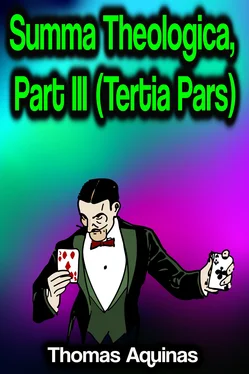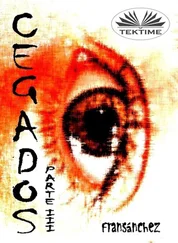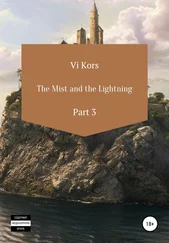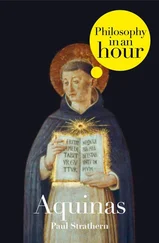Reply Obj. 3: Although it belongs to Christ as God to take away sin authoritatively, yet it belongs to Him, as man, to satisfy for the sin of the human race. And in this sense He is called the Mediator of God and men. _______________________
ST. THOMAS AND THE IMMACULATE CONCEPTION (EDITORIAL NOTE)
The privilege of the Virgin-Mother of God and the supreme prerogative of her Son may be seen from the following diagram:
THE LAW AND COURSE OF ORIGINAL SIN.
[The following content was presented in the form of a three-column table in the original.]
[COLUMN 1] UNDER THE LAW.
All descendants from Adam.
Spring from Adam materially and seminally.
The body lies (not under the guilt, but) under the effects of original sin.
The stricken body dispositively causes the soul to contract the guilt of original sin.
The soul at the moment of union with the body contracts the stain.
All contract both debt and stain.
All need a Redeemer to destroy the stain contracted.
[COLUMN 2] PARTIALLY EXEMPT FROM THE LAW; PRIVILEGE OF IMMACULATE CONCEPTION.
Spring from Adam materially and seminally.
The body lies (not under the guilt, but) under the effects of original sin.
The stricken body would have dispositively caused the soul to contract the guilt of original sin.
The soul at the moment of union with the body was prevented by the infusion of grace from contracting the stain.
Mary contracted the debt, but not the stain.
Mary needed a Redeemer to prevent her from contracting the stain.
[COLUMN 3] WHOLLY EXEMPT FROM THE LAW; MIRACULOUS CONCEPTION.
Springs from Adam materially, not seminally. (Q. 31, A. 1)
His body lay under neither guilt nor effects of original sin.
The body being entirely free, could not transmit the stain to His soul.
No preventive grace needed.
Jesus Christ contracted neither debt nor stain.
Jesus Christ is not redeemed, but the Redeemer.
It will thus be seen how accurately St. Thomas speaks of the "flesh" or body of our Blessed Lady. For it should be remembered that, according to St. Thomas, the human body is animated in succession by (1) a vegetative, (2) a sensitive, and (3) a rational soul. Hence his assertion that "the flesh of the Blessed Virgin was conceived in original sin" (Q. 14, A. 3, ad 1) means that the body of the Blessed Virgin, being descended from Adam both materially and seminally, contracted the bodily defects which are conveyed by seminal generation, and are the results of the privation of original justice (Q. 69, A. 4, ad 3). Before animation, therefore the body of the Blessed Virgin would not be infected with the guilt of original sin, because privation of grace can only be in that which is the subject of grace, viz. the rational soul. Nevertheless, before animation the body of the Blessed Virgin, being seminally descended from Adam, was such that it would have been the means of transmitting the taint of original sin to the rational soul at the very first instant of animation, unless the grace of the Redeemer intervened and sanctified her soul "in that self-same instant," thus redeeming her and preventing her from contracting the guilt of original sin.
Why, then, does St. Thomas say that because the Blessed Virgin was not sanctified before animation, therefore she could be sanctified only after animation?
Such a conclusion would hold if it were a question of the order of Nature: "a thing must be before it is such ( prius est esse quam esse tale )"; and therefore the soul must be, before it is sanctified. But if St. Thomas held for a posteriority of time, no matter how short, we ask how it was that he did not perceive the fallacy of the argument, since it might be neither before nor after, but in the very instant of, animation.
The question is answered thus: St. Thomas as a Doctor of the Church and in matters which were not then de fide, is a witness to the expression of the faith of his time. Hence his line of argument coincides with, because it follows, that of St. Bernard, Peter Lombard, Alexander of Hales, Albert the Great, St. Bonaventure. It was not likely that St. Thomas would differ from the great masters of his time, who failed to understand that the grace of redemption might at the same time be one of preservation and prevention. Nor is it likely that St. Thomas had any reliable information about the movement* in progress at that time towards a belief in the Immaculate Conception. [*Principally in England, where, owing to the influence of St. Anselm (1109), the doctrine was maintained by Eadmer (1137). Nicolas of St. Albans (1175), Osbert of Clare (1170), Robert Grosseteste, Bishop of Lincoln (1253), William of Ware (1300), who was the master of Duns Scotus (1308)]. No doubt he knew something of it, but the names of its promoters would have weighed little with him as against those of Bernard, Albert, Peter, Alexander, and Bonaventure. And it must not be forgotten that among those who upheld the doctrine of the Immaculate Conception, not a few ascribed the privilege as being absolute and not one of preservation and Redemption. Hence it is that St. Thomas insists on two things: (1) that the Mother of God was redeemed, and (2) that the grace of her sanctification was a grace of preservation. And, be it remarked in conclusion, these two points, so much insisted on by St. Thomas, are at the very basis of the Catholic doctrine of the Immaculate Conception.
Question 27. Of The Sanctification Of The Blessed Virgin (In Six Articles)
After the foregoing treatise of the union of God and man and the consequences thereof, it remains for us to consider what things the Incarnate Son of God did or suffered in the human nature united to Him. This consideration will be fourfold. For we shall consider: (1) Those things that relate to His coming into the world; (2) Those things that relate to the course of His life in this world; (3) His departure from this world; (4) Those things that concern His exaltation after this life.
The first of these offers four points of consideration: (1) The Conception of Christ; (2) His Birth; (3) His Circumcision; (4) His Baptism. Concerning His Conception there are some points to be considered: (1) As to the Mother who conceived Him; (2) as to the mode of His Conception; (3) as to the perfection of the offspring conceived.
On the part of the Mother four points offer themselves to our consideration: (1) Her sanctification. (2) her virginity; (3) her espousals; (4) her annunciation, or preparation for conception.
Concerning the first there are six points of inquiry:
(1) Whether the Blessed Virgin, Mother of God, was sanctified before her birth from the womb?
(2) Whether she was sanctified before animation?
(3) Whether in virtue of this sanctification the fomes of sin was entirely taken away from her?
(4) Whether the result of this sanctification was that she never sinned?
(5) Whether in virtue of this sanctification she received the fulness of grace?
(6) Whether it was proper to her to be thus sanctified? _______________________
FIRST ARTICLE [III, Q. 27, Art. 1]
Whether the Blessed Virgin Was Sanctified Before Her Birth from the
Womb?
Objection 1: It would seem that the Blessed Virgin was not sanctified before her birth from the womb. For the Apostle says (1 Cor. 15:46): "That was not first which is spiritual but that which is natural; afterwards that which is spiritual." But by sanctifying grace man is born spiritually into a son of God according to John 1:13: "(who) are born of God." But birth from the womb is a natural birth. Therefore the Blessed Virgin was not sanctified before her birth from the womb.
Obj. 2: Further, Augustine says (Ep. ad Dardan.): "The sanctification, by which we become temples of God, is only of those who are born again." But no one is born again, who was not born previously. Therefore the Blessed Virgin was not sanctified before her birth from the womb.
Читать дальше












